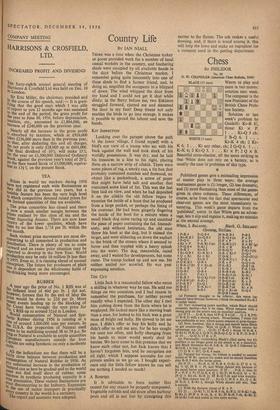Chess
By PHILIDOR
No. 80 G. W. CHANDLER (American Chess Bulletin, 1948) NVIIITE (5 rum)
mate in two moves: solution next week. The composer is the new President of the British Chess Prob- lem Society.
Solution to last week's problem by Guidelli: Kt-B 8!, threat Kt X P.
1 . . Kt-Q 5 ch; 2 B-Q 6. 1 . • . Kt-K 4 ch; 2 Kt- K 6. 1 . . . Kt any other, ch; 2 Q-Q 6. 1 . . . K-K 4; 2 Kt-Q 3. 1 . . . Kt x P; 2 Q x B. Beautiful cross-checker, all the more striking in that White does not rely on a battery, as is usually the case in problems of this type.
Published games give a misleading impression of master play in three ways: the average tournament game is (1) longer, (2) less dramatic, and (3) more fluctuating than most of the games given in chess columns. These differences, of course, arise from the fact that spectacular and clear-cut games are the most immediately in- teresting. This week's game departs from the 'published' norm in that White gets an advan- tage, lets it slip and regains it, making no mistake at the second attempt.
White, 1. BALANEL Black, G. Szu-Hoyt
Opening, Sicilian
1P-x 4 P-Q a 4 20 B-K B 1 P-B 3
2 Kt-K B 3 Kt-e/ B 3 21 R-Q 4 (e) P x P 3 P-Q 4 P x P 22 P X P B x PI
4 Kt x P P-K Kt 3 (a) 23 K-B 2 (f) B x B? (g)
S P-Q B 4 B-Kt 2 24 K x B 341-13 3 6 8-K 3 Kt-B 3 25 R-Q 51 P-Kt 4 (h) 7 Kt-Q B 3 Kt-K Kt 5 26 R x Kt P Q-Q 3
8 Q x Kt Kt x Kt 27 Q-K 2 0-0-0? (0
9 Q-Q 1 Kt-K 3 28 Q-11 3I(J) P-K 4 10 Q R-B I Q-R 4 29 R x P Q-Q ch I I B-K 21 (b) B x Kt ch 30 K-B 2 Q-B 7 cb I2RxB Q x P 31 K-K I P-K 5 (k) 13 Q-B I Q-R 4 32 R-R 8 ch K-B 2 14 0-0 P-Kt 3 33 B-Kt 6 ch K-Kt 2 15 R-R 3 Q-Q Kt 5 (c) 34 13-B 5 ch K-I3 2 16 P-8 4? (d) I3-Kt 2 35 B-Q 6 chi K x 13 17 P-K B 5 Kt-Q 1 36 Q-R 3 ch K-B 2 18 Q-B 2 R-K Kt 1 37 R-R 7 cb Kt x R 19 R-Q 1 B-B 3 38 Q x Kt ch K-Q 3 39 Q-B 5 irate (a) Formerly thought to be inferior, this move has recently been revived: however, 1 think the standard Kt-B 3 is rather better.
(b) Very interesting pawn sacrifice, which Black should probably decline—but if he does, White remains with a strong grip on the centre and an excellent position. (c) It 15 Q-K 4; then 16 P-K 4 (16 Q x K P77: 17 B-B 3) with a strong attack. Nevertheless, 1 think this was preferable to text, where queen remains in great danger. (d) Now, however, this is wrong and merely helps Black to get counter-play. With 16 Q-R 11 White retains the advantage, e.g. 16 . . . 0-0; 17 R-Q I threat 18 R-R 4, Q-Kt 6; 19 R-Q 3, Q-B 7; 20 R-Q 2, Q x K P; 21 B-B 3 or 16 ... Q-Q 3; 17 R x P.
(e) Presumably overlooking Black's 22nd move, but his position is no longer good as his attack is at a standstill, and Black threatens Kt-B 2-K 4. 21 Q-B 2 followed by R(I)-R 1 is best I can find.
(f) 23 B x B??, Q-K 8 mate. (?) Natural but wrong; his bishop is needed to control action of W Its against his queen and he should therefore play B-B 3 with the better game.
(11) If 2.5 . Kt-R 4; 26 11-R 4, Q-Kt 6; 27 Q x Q, Kt x 0; 28 B x PI, and White should win because of his much better piece position. If 25 . . . P-K 3; then 26 P x P, P x P; 27 Q-K 4, Q x Kt P; 28 R-Q 6, Q x 11; 29 Q x Kt ch, K-B 2; 30 R-Q 7 ch and wins wuickly. (i) Best chance was 27 ... Kt-Q 5; 28 B x Kt, Q x
29 R-K 3, R-Kt 2, though White should still win. Test is suicide.
(I) With the decisive threat of 11 X P.
(k) 31 .. . Q-Kt 7; 32 R-R 8 eh, K-B 2; 33 II-Kt 6 C43, K-Kt 2; 34 B x R ch, K x It; 35 11-11 5 ch, K.-Kt 2; 36 Q-Kt 3 ch and mates in two more moves.










































 Previous page
Previous page